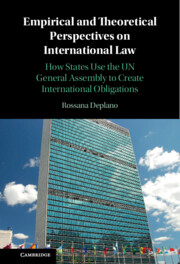 Empirical and Theoretical Perspectives on International Law
Empirical and Theoretical Perspectives on International Law Book contents
- Empirical and Theoretical Perspectives on International Law
- Empirical and Theoretical Perspectives on International Law
- Copyright page
- Dedication
- Contents
- Figures
- Tables
- Acknowledgements
- Introduction
- 1 Unpacking the Practice of the General Assembly
- 2 The Legal Significance of Resolutions at the Adoption Stage
- 3 The Legal Significance of Resolutions within Domestic Legal Systems
- 4 The Legal Significance of Resolutions in International Practice
- 5 Revisiting the Concept of Legal Significance of Resolutions
- Conclusions
- Appendix Empirical Research Design
- Index
1 - Unpacking the Practice of the General Assembly
Published online by Cambridge University Press: 21 July 2022
- Empirical and Theoretical Perspectives on International Law
- Empirical and Theoretical Perspectives on International Law
- Copyright page
- Dedication
- Contents
- Figures
- Tables
- Acknowledgements
- Introduction
- 1 Unpacking the Practice of the General Assembly
- 2 The Legal Significance of Resolutions at the Adoption Stage
- 3 The Legal Significance of Resolutions within Domestic Legal Systems
- 4 The Legal Significance of Resolutions in International Practice
- 5 Revisiting the Concept of Legal Significance of Resolutions
- Conclusions
- Appendix Empirical Research Design
- Index
Summary
This chapter provides an overview of the General Assembly’s decision-making powers and related functions. The UN Charter describes resolutions of the General Assembly as recommendations. However, the letter of the UN Charter does not exclude the possibility that resolutions may acquire legal significance, which is a matter of empirical assessment. The chapter then analyses seven decades of General Assembly practice. Based on an original dataset, it sheds light on the working methods and practices informing the functioning of the General Assembly in plenary session as well as its six main committees. For each of them, it provides information about the number of resolutions adopted, their subject matter and voting patterns. The empirical analysis is useful to shed light on the degree of autonomy of the General Assembly from its member states through the analysis of the body of practice developed by both the plenary session and its six main committees. Building on the empirical findings, the chapter elaborates on the concept of autonomy of the General Assembly and its connection with the process through which resolutions acquire legal significance. It concludes by pointing out that it is not possible to generalize about the functioning of the General Assembly and, consequently, the legal significance of resolutions.
Keywords
- Type
- Chapter
- Information
- Empirical and Theoretical Perspectives on International LawHow States Use the UN General Assembly to Create International Obligations, pp. 25 - 66Publisher: Cambridge University PressPrint publication year: 2022


